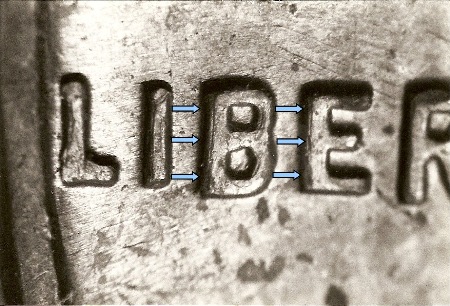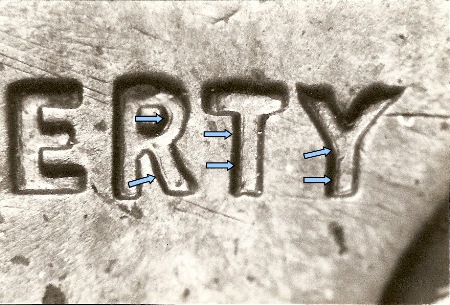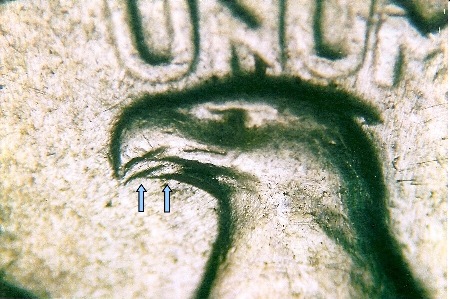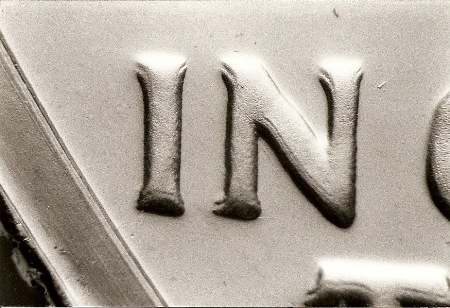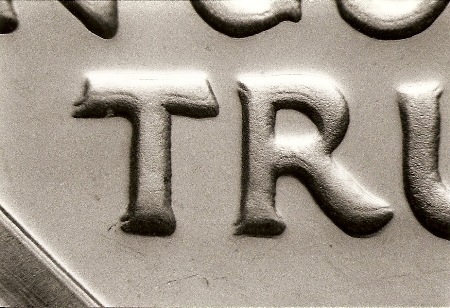


 |
 |
 |
 |
 |
 |
 |
 |
 |
 |
 |
 |
 |
 |
 |
 |
 |
 |
 |
 |
 |
 |
 |
 |
Once we have a satisfactory master die for a given year, it is time to use that master die to produce working hubs. Those working hubs will then be used to produce the working dies which will then be used to strike the coins. The process for producing the working hubs for a given year is identical to the process already discussed for making the master die. The master die is placed in the hubbing press. In the older multiple-squeeze hubbing presses it was clamped into the top of the hubbing chamber and a hub blank was placed directly below it. In the single-squeeze hubbing presses it rests on the top of the hub blank in a collar at the bottom of the hubbing press. When the press is activated hundreds of tons of pressure squeeze the face of the master die into the face of the blank steel rod that will become the working hub. In the older multiple-squeeze hubbing presses it would require more than one hubbing to create a satisfactory impression in the working hub. The working hub had to be removed from the hubbing press and heated in an annealing oven to soften the steel for the next impression in the hubbing press. As with the production of the master die, if there was any kind of misalignment between the image on the master die and the incomplete image on the working hub, the result would be a doubled image where the misalignment of images occurred. In the single-squeeze hubbing presses lateral or twisting movements of the hub during the single-squeeze can result in some minor misalignments of images as well. Since the working hubs would then be used to produce the working dies for that year, the doubling on that doubled working hub would be transferred to all of the working dies made by that working hub. Likewise, the doubling would then be transferred to all coins struck by those working dies. The working hub is capable of producing hundreds of working dies. If the doubling is minor and not easily seen, it could produce a large number of doubled working dies and a large number of coins will be affected in a given year. On the other hand, if the doubling is fairly strong and easy to see, the doubled working hub may be removed from service before too many doubled working dies are produced and coins with the doubling may prove to be desirable even though several working dies may be affected. Either way the key to recognizing that a doubled working hub is the culprit for the doubling found on coins in a given year is that more than one working die will be identified with exactly the same doubling. In 1961 the Mint produced a doubled working hub for the obverse of the Lincoln cents. A significant number of working dies for both the Philadelphia and Denver Mints have been identified with exactly the same doubling. The doubling shows on the left side of the letters of LIBERTY. This may well be a case of where the doubling of the working hub was not discovered or perhaps even ignored as these are relatively easy to find indicating that a large number of working dies were affected. I am not aware of any proof dies being produced with this doubling, but their existence would not surprise me.
These photos show the doubling that can be found on a large number of P-Mint and D-Mint Lincoln cents for 1961. The culprit was a doubled working hub that produced quite a few working dies all with the same doubling. 1989 saw the production of another doubled working hub for the Lincoln cents, but this one was for the reverse. Close doubling can be seen on the bottoms of the letters of E PLURIBUS UNUM, the dots, and the lower AM in AMERICA. This one is a lot more difficult to find that the 1961 working hub doubled cents, so it may be a case where the doubling was discovered and the working hub removed from production before too many working dies were affected. An example of strong doubling on dies produced from a doubled working hub can be found on the reverse of some 1941 Washington quarters. The doubling shows as a very strongly doubled eagle's beak along with doubling on the underside of the branches in the wreath. Some of the leaves on the left side of the reverse also show some doubling. We have recorded 10 different working dies with exactly the same doubling. Relatively speaking, that is not a lot so it is not that easy to find examples of this variety and due to the strength of the doubling it does maintain a premium value above normal 1941 Washington quarters.
This strongly doubled eagle's beak can be found on at least 10 different P-Mint working dies for the 1941 Washington quarters.
The doubling on the underside of these branches is part of the working hub doubling found on the reverse of some 1941 Washington quarters. The 1971 Eisenhower dollars are a prime source for examples of doubled working hubs. The Wexler Doubled Die Files once had 104 listings for obverse doubled dies on the 1971-S Eisenhower dollars, but some keen detective work by die variety specialist Brian Allen whittled the number down to 16 obverse doubled die varieties with the rest of the varieties being specimens of one of eight different doubled working hubs now known for the obverse of the 1971 Eisenhow dollars.
This nice doubling seen on the obverse of a 1971-S Proof Eisenhower dollar is one example of the doubled working hub we know have listed as 1971-S $1 WWHO-008.
This doubling on the TR of TRUST is also part of the doubled working hub doubling seen on 1971-S $1 WWHO-008. Because the doubling on coins resulting from doubled working hubs is not as common as that produced from doubled master dies, some doubled die collectors do view these as collectible varieties, especially when it is apparent that not many working dies were affected as in the case of the 1941 quarter reverse. The decision of whether or not to collect them must be made by each individual collector. Just remember that since these are more common than doubled dies for which just a single working die was affected, they should not command the premiums seen for those varieties for which just a single working dies was affected. | ||


